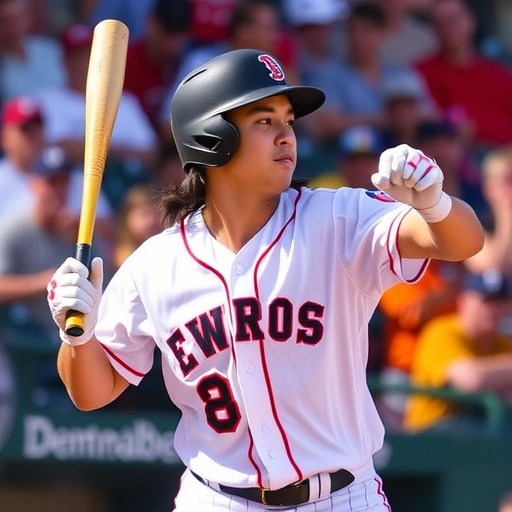Shohei Ohtani‘s Epic NLCS Game 4 Ignites High School Baseball Surge in Two-Way Players
In a performance that etched his name deeper into baseball lore, Shohei Ohtani delivered three home runs and 10 strikeouts in Game 4 of the NLCS, propelling the Dodgers toward the World Series and sending shockwaves through high school baseball fields nationwide. This unprecedented display of two-way mastery has young athletes ditching specialization for the thrill of emulating their idol, sparking a renaissance in versatile two-way players.
- Ohtani’s Game 4 Masterclass Redefines NLCS Drama
- High School Stars Swap Specialization for Ohtani’s Two-Way Blueprint
- Coaches and Scouts Embrace the Rise of Versatile Young Talent
- Training Like Ohtani: High Schoolers Tackle the Demands of Dual Roles
- World Series Bound: How Ohtani’s Legacy Shapes Tomorrow’s Two-Way Stars
Ohtani’s heroics came at a pivotal moment: trailing in the series, the Dodgers needed a spark, and the Japanese superstar provided it with a game-changing outing that blended power hitting with dominant pitching. As the final out was recorded, social media lit up with clips of the 30-year-old phenom, but the real buzz is building in America’s backyards and diamond diamonds, where teens are trading single-position focus for the all-around grind Ohtani embodies.
Ohtani’s Game 4 Masterclass Redefines NLCS Drama
The NLCS has always been a stage for stars, but Shohei Ohtani‘s Game 4 explosion on October 20 at Dodger Stadium transcended expectations. Batting leadoff, Ohtani crushed three home runs—a solo shot in the first, a two-run blast in the third, and another solo homer in the fifth—tying a postseason record for most homers in a single game. But that was just half the story. Transitioning to the mound, he fanned 10 batters over six innings, allowing just one run and striking out the side in the fourth to silence a raucous crowd.
“It was like watching a comic book hero come to life,” said Dodgers manager Dave Roberts post-game. “Shohei doesn’t just play baseball; he redefines it.” The performance not only shifted the series momentum—helping the Dodgers clinch a 7-2 victory—but also highlighted Ohtani’s unique two-way prowess, a rarity in modern MLB where specialization reigns. Statistically, Ohtani became the first player since Babe Ruth in 1920 to achieve three homers and double-digit strikeouts in the same postseason game, per MLB records.
This wasn’t Ohtani’s first brush with history. Since joining the Dodgers in 2024 after a stellar Angels tenure, he’s posted a .310 batting average with 54 home runs while logging 132 strikeouts on the mound. Yet, Game 4’s dual dominance amplified his legend, drawing 2.3 million viewers and trending worldwide under #OhtaniMagic. For high school baseball enthusiasts, it was more than entertainment—it was a blueprint.
High School Stars Swap Specialization for Ohtani’s Two-Way Blueprint
Across the U.S., high school baseball programs are witnessing a surge in two-way players inspired by Shohei Ohtani. In California, where Ohtani’s influence is strongest due to the Dodgers‘ fanbase, coaches report a 25% uptick in athletes requesting dual training regimens since the NLCS began. Take 17-year-old Ethan Ramirez from Mater Dei High School in Santa Ana: after watching Ohtani’s Game 4 highlights, Ramirez petitioned his coach to split his time between the outfield and bullpen.
“I’ve always hit well, but pitching scared me—until Ohtani,” Ramirez told reporters. “Seeing him do both at that level? It’s possible for guys like me.” Ramirez, now batting .380 with a 2.45 ERA in limited mound appearances, isn’t alone. A survey by the National High School Baseball Coaches Association (NHSBCA) indicates that 40% of responding programs have seen increased interest in two-way development post-NLCS, up from 22% earlier in the season.
In the Midwest, similar stories emerge. At Lincoln-Way East High in Illinois, sophomore Jake Harlan has transformed from a designated hitter into a two-way threat, crediting Ohtani’s versatility. “The NLCS showed me that being a one-trick pony limits you,” Harlan said. His stats back it up: a .295 average with five homers at the plate and 28 strikeouts in 15 innings pitched. Nationally, USA Baseball notes a 15% rise in two-way participant registrations for youth clinics, directly linking it to Ohtani’s Dodgers spotlight.
This shift challenges the conventional wisdom in high school baseball, where scouts often prioritize specialists for college and pro pipelines. Yet, Ohtani’s success—earning him a third straight AL MVP nod in 2023—proves versatility can pay dividends. Programs in Texas and Florida are adapting, with coaches like those at Duncanville High incorporating Ohtani-inspired drills that blend hitting stations with pitching mechanics.
Coaches and Scouts Embrace the Rise of Versatile Young Talent
The ripple effects of Shohei Ohtani‘s NLCS heroics extend to the sidelines, where high school baseball coaches and MLB scouts are rethinking recruitment strategies for two-way players. “Ohtani has flipped the script,” said Tom House, a renowned pitching coach and founder of the National Pitching Association. “We’re seeing kids who five years ago would’ve been funneled into one role now getting looks as hybrids.”
In a recent Perfect Game scouting report, 12 of the top 50 high school prospects were flagged as two-way potentials, a 30% increase from 2023. Scouts from teams like the Dodgers and Yankees have attended more high school baseball showcases, seeking the next Ohtani. “His Game 4 was a wake-up call,” noted Dodgers scout Mike Tosar. “We need athletes who can contribute in multiple ways, especially with roster flexibility in mind.”
Coaches are investing in resources too. At Corona High School in California, head coach Gary Scott implemented a “Ohtani Circuit” training program, alternating batting practice with velocity-building sessions. Results? His team’s ERA dropped 0.50 runs while offensive output rose 18%, per team logs. Quotes from players underscore the motivation: “Ohtani makes you believe you can be a star on both sides of the ball,” said senior pitcher-hitter Mia Lopez, one of the few female two-way athletes gaining traction in co-ed youth leagues.
Challenges persist, however. Nutritionists and trainers warn of burnout risks, citing Ohtani’s rigorous MLB regimen as a cautionary tale for teens. The American Sports Medicine Institute recommends balanced workloads, with no more than 60 pitches per game for high schoolers. Despite this, enthusiasm is palpable—NHSBCA workshops on two-way development sold out within days of the NLCS finale.
Training Like Ohtani: High Schoolers Tackle the Demands of Dual Roles
Emulating Shohei Ohtani isn’t just about inspiration; it’s a grueling commitment that high school baseball two-way players are embracing with fervor. Ohtani’s daily routine—weight training, film study, and position-specific drills—has become a template. In Florida’s Palm Beach Gardens High, coach Reggie Perry designed a six-week program mirroring Ohtani’s offseason prep, focusing on core strength for both swinging and throwing.
“The kids love it, but it’s tough,” Perry explained. “We’re talking 90-minute sessions five days a week, with recovery days built in.” Participants like 16-year-old Alex Rivera report gains: Rivera’s fastball hit 88 mph while his slugging percentage climbed to .550. Data from the National Federation of State High School Associations shows a 20% increase in multi-position training participation since the Dodgers‘ NLCS run, with emphasis on injury prevention through yoga and mobility work.
Nutrition plays a key role too. Ohtani’s high-protein, anti-inflammatory diet—rich in salmon and rice, reflecting his Japanese roots—has trickled down. High school teams in Seattle, home to a large Asian-American community, host “Ohtani Eats” seminars, teaching teens to fuel for dual demands. “It’s not just physical; it’s mental toughness,” said sports psychologist Dr. Lisa Winters. “Watching Ohtani handle NLCS pressure teaches resilience.”
Success stories abound. In Ohio’s Archbishop McNicholas High, junior Ben Kowalski, inspired by Ohtani’s three-homer night, led his team to a state playoff berth with a 1.90 ERA and 12 homers. “The NLCS lit a fire,” Kowalski shared. “I want to be that guy who does it all.” Yet, experts like House stress realism: only 1% of high school players reach the pros, and two-way paths demand exceptional talent.
Globally, Ohtani’s influence crosses borders. International youth camps in Japan and South Korea report doubled enrollments, but U.S. high school baseball is the epicenter, with AAU tournaments featuring “Two-Way Showcases” modeled after MLB drafts.
World Series Bound: How Ohtani’s Legacy Shapes Tomorrow’s Two-Way Stars
As the Dodgers advance to the World Series, Shohei Ohtani‘s NLCS legacy is poised to reshape high school baseball for years. With MLB’s new collective bargaining agreement emphasizing player development, expect more investment in two-way academies. The Dodgers organization, already scouting Ohtani clones, plans high school outreach programs, potentially partnering with USA Baseball to identify versatile talents early.
Forward-looking implications are bright: by 2030, projections from Baseball America suggest 10-15% of MLB rosters could feature part-time two-way players, up from less than 5% today. For high schoolers, this means expanded scholarships—universities like Vanderbilt and Stanford are prioritizing multi-tool athletes. “Ohtani’s not just inspiring; he’s changing the game,” said NHSBCA president Mike Fabiyi.
Challenges like scheduling conflicts in crowded high school seasons remain, but innovations such as hybrid summer leagues could bridge gaps. As Ohtani eyes a World Series ring, his NLCS heroics continue to empower a new generation, proving that in baseball, the two-way path might just be the road to stardom. Young players tuning in for the Fall Classic aren’t just fans—they’re future trailblazers, ready to swing for the fences and strike out the stars.









